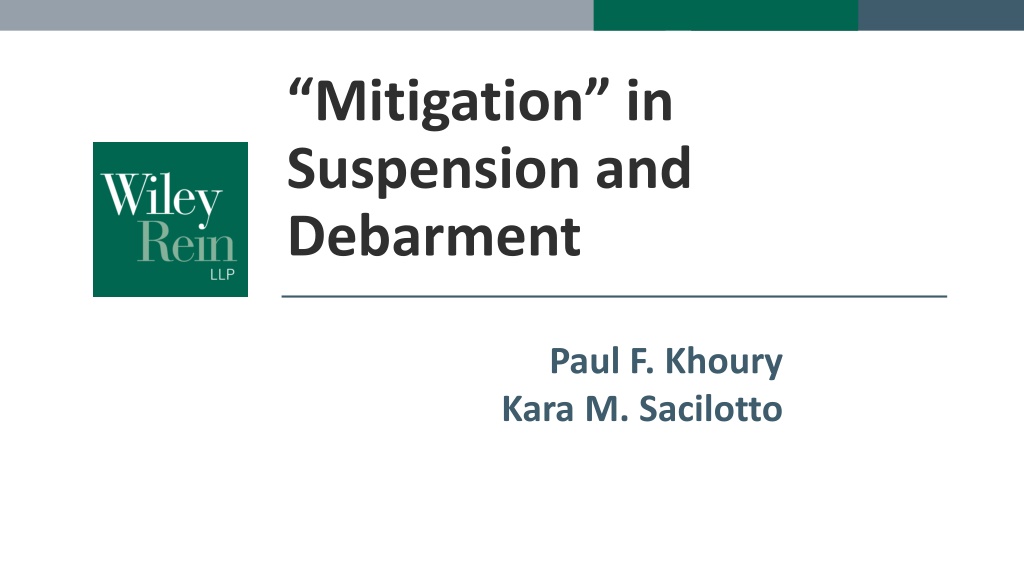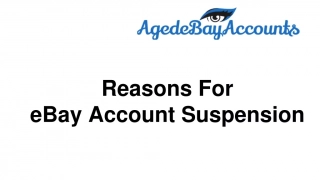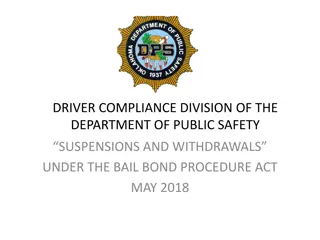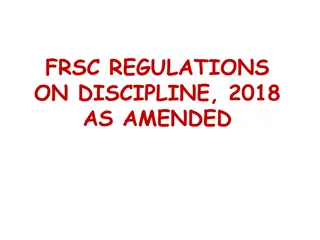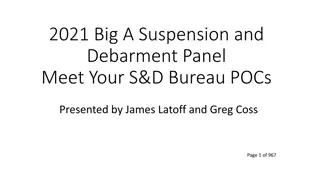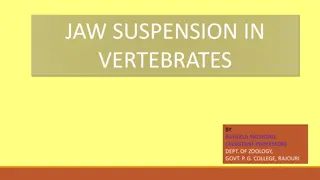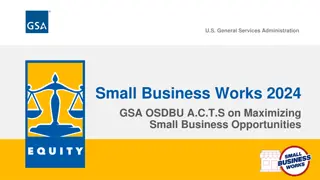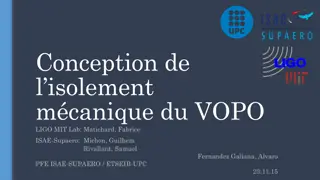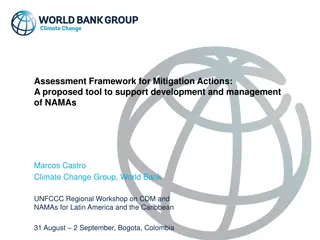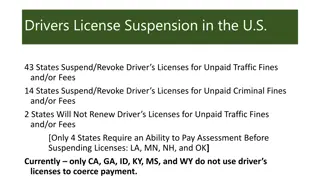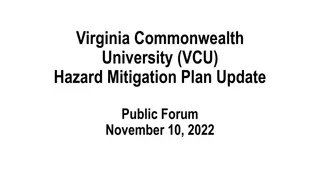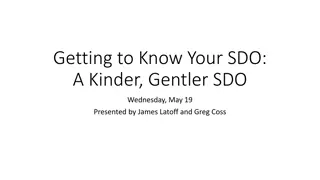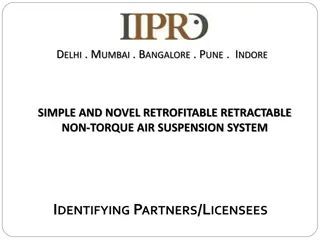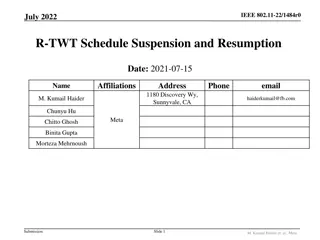Understanding Mitigation in Suspension and Debarment Procedures
Delve into the significance of mitigating factors in Suspension and Debarment cases under the FAR and NCR regulations. Explore how these factors impact decision-making by debarring officials and the statistics surrounding suspension/debarment actions. Discover the parallels between FAR mitigating factors and US Sentencing Guidelines for organizations, shedding light on the necessity of assessing mitigating and aggravating factors in such cases.
Download Presentation

Please find below an Image/Link to download the presentation.
The content on the website is provided AS IS for your information and personal use only. It may not be sold, licensed, or shared on other websites without obtaining consent from the author. Download presentation by click this link. If you encounter any issues during the download, it is possible that the publisher has removed the file from their server.
E N D
Presentation Transcript
Mitigation in Suspension and Debarment Paul F. Khoury Kara M. Sacilotto
What Well Cover Quick reminder why mitigating (or aggravating) factors are relevant Suspension/Debarment Statistics FAR s mitigating factors As applied to an organization Similarity to US Sentencing Guidelines for organizations FAR 52.203-13 As translated to apply to an individual Yeats Memo Nonprocurement Common Rule (NCR) mitigating and aggravating factors
Why Are We Even Talking About Mitigating Factors? They Did It! Under both the FAR and the NCR, a debarring official (SDO) has discretion and is not required to suspend/debar a contractor, even if cause exists or existed at one time. FAR 9.406-1; 2 C.F.R. 180.845 FAR provides that debarment is not for purposes of punishment and to protect the Government s interest. FAR 9.402(b) To decide whether suspension/debarment is necessary to protect the United States and whether the contractor is presently responsible, despite misconduct in its past, SDO considers the FAR and NCR mitigating/aggravating factors
Suspension/Debarment Statistics Interagency Suspension and Debarment Committee reports to Congress every year on suspension/debarment actions by Executive agencies covered by CFO Act Began reporting in 2009/2010. From this first report:
Suspension/Debarment Statistics By FY14 (a high water mark): By FY17 (levels out) Pre-Notice Letters (e.g., Show Cause) jump up 21% from FY16 Actions FY14 Suspensions 1009 Actions FY17 Proposed Debarments 2229 Suspensions 604 Debarments 1929 Proposed Debarments 1613 Show Cause Letters 161 Debarments 1423 Pre-Notice Letters 193 Pro-Active Outreach 53
Sentencing Guidelines (Organizations) FAR mitigating factors closely track USG Sentencing Guidelines 8B1.1, Restitution 8B1.2, Remedial Orders 8B2.1, Effective Compliance and Ethics Program 8C2.5(f), (g), Culpability Score Effective Compliance and Ethics Program Self-Reporting, Cooperation, and Acceptance of Responsibility
FAR Internal Controls and Mandatory Disclosure Requirements (Organizations) FAR 52.203-13 also has connection to US Sentencing Guidelines and DOJ push for more disclosure of wrongdoing. Also repeats some of the factors that mitigate against exclusion in FAR 9.406-1 Business ethics awareness and compliance program, generally tracks Sentencing Guidelines requirements for effective compliance and ethics program Internal control system that allows the company to timely discover improper conduct Mandatory Disclosure requirements in FAR 52.203-13: Must timely disclose credible evidence of certain procurement-related federal criminal violations and violations of civil False Claims Act Applies to all covered contracts (>$5.5M and 120 days), and must be flowed down to subcontractors Although small businesses and commercial item contracts exempt from 52.203-13(c) compliance program and internal controls requirements, not exempt from mandatory disclosure obligations. See FAR 52.203-13(b)
Yates Memo (Individuals) Since 2015, Department of Justice has increased focus on individual accountability. See Memorandum from (former) Deputy Attorney General Sally Yates (Sept. 9, 2015); see (former) DAG Yates Remarks at American Banking Association and ABA Conference (November 16, 2015) The substantial challenges unique to pursuing individuals for corporate misdeeds[] make it all the more important that the Department fully leverage its resources to identify culpable individuals al all levels in corporate cases. Absent extraordinary circumstances or approved departmental policy, the Department will not release culpable individuals from civil or criminal liability when resolving a matter with a corporation [T]o be eligible for any credit for cooperation, the company must identify all individuals involved in or responsible for the misconduct at issue, regardless of their position, status or seniority. . . Belief that exclusions rose at the expense of individuals
FAR 9.406-1 Mitigating Factors As Applied to Organization (1) Whether the contractor had effective standards of conduct and internal control systems in place at the time of the activity . Was the contractor at least TRYING to be responsible by having standards of conduct in effect; OR Was the contractor flying without a net Idea is that one can try to prevent bad actions/actors, but cannot realistically ensure 100% compliance 9
FAR 9.406-1 Mitigating Factors Translated to An Individual (1) Whether the contractor had effective standards of conduct and internal control systems in place at the time of the activity . TRANSLATION? Did the individual receive appropriate/adequate training prior to the time of the activity? 10
FAR 9.406-1 Mitigating Factors As Applied to Organization (2) Whether the contractor brought the activity cited . . . to the attention of the appropriate Government agency in a timely manner? Did the contractor self-disclose the matter? Note that this FAR provision pre-dates the requirements in FAR 52.203-13 that mandate disclosure of certain federal crimes and violations of the civil False Claims Act. Now, focus may be on the timeliness and fulsomeness of a required disclosure or, if not a mandatory disclosure issue, whether the contractor self-disclosed it. 11
FAR 9.406-1 Mitigating Factors Translated to An Individual (2) Whether the contractor brought the activity cited . . . to the attention of the appropriate Government agency in a timely manner? TRANSLATION? Was the individual a whistleblower? Did the individual deny misconduct or acknowledge responsibility? 12
FAR 9.406-1 Mitigating Factors As Applied to Organization Factor is straightforward: is the contractor being forthcoming/transparent with the Agency? Is the contractor putting its head in the sand ? Did it conduct an inadequate investigation? Is it withholding factual material from its investigative findings? Is it willing or unwilling to answer questions? Note: Most SDOs, like DOJ, would not require a waiver of attorney- client privilege to satisfy this mitigating factor. BUT, remember that facts are not privileged (3) Whether the contractor has fully investigated the circumstances surrounding the cause for debarment and, if so, made the result of the investigation available to the debarring official 13
FAR 9.406-1 Mitigating Factors Translated to an Individual (3) Whether the contractor has fully investigated the circumstances surrounding the cause for debarment and, if so, made the result of the investigation available to the debarring official TRANSLATION? What is source of the record for the action against the individual? Is that record fully developed or is the action based solely on an employer disclosure (even one made out of an abundance of caution ?), circumstantial evidence, or an Agency investigation (with no input from the contractor and/or individual)? 14
FAR 9.406-1 Mitigating Factors As Applied to Organization (4) Whether the contractor cooperated fully with Government agencies during the investigation and any court or administrative action. Did the contractor cooperate with: An Agency investigation (e.g., OIG inquiry)? DOJ during any civil or criminal matter? The SDO office? Or, has the contractor taken an adversarial position and refused to cooperate? 15
FAR 9.406-1 Mitigating Factors Translated to An Individual TRANSLATION? Did the individual cooperate with: The contractor s internal investigation? An agency investigation? DOJ during any civil or criminal matter? The SDO office? But what if there is an ongoing criminal prosecution? Individual has 5th Amendment right against self-incrimination. (4) Whether the contractor cooperated fully with Government agencies during the investigation and any court or administrative action. 16
FAR 9.406-1 Mitigating Factors As Applied to Organization (5) Whether the contractor has paid or has agreed to pay all criminal, civil, and administrative liability . . . and has made or agreed to make full restitution (6) Whether the contractor has taken appropriate disciplinary action against the individuals responsible (5) Has the organization (preferably voluntarily) made necessary monetary restitution to: the Agency? the United States through a civil or criminal settlement with DOJ? Pay other liabilities (e.g., back taxes and penalties?) to the United States? (6) Not just did the organization take disciplinary action against someone, but did it take APPROPRIATE disciplinary action? Did it narrowly focus on scape goats or also look more broadly to see if culpable supervisors, managers, or even Officers and Directors? 17
FAR 9.406-1 Mitigating Factors Translated to An Individual (5) Whether the contractor has paid or has agreed to pay all criminal, civil, and administrative liability . . . and has made or agreed to make full restitution (6) Whether the contractor has taken appropriate disciplinary action against the individuals responsible TRANSLATION? (5) Usually hard for a non- owner/officer to give money back to the Agency under a contract Did the individual: Pay criminal penalties to DOJ? Pay other liabilities (e.g., back taxes and penalties?) to the USG? (6) Has the individual been disciplined and/or terminated? Did the company scape goat the individual when higher ups required the (mis)conduct? 18
FAR 9.406-1 Mitigating Factors Applied to Organization (7 and 8) Has the contractor self-identified means for prevent a recurrence of the misconduct? Additional training? Revised policies? Revised operating practices? Implement technology fixes ? Remediation to Government also a factor: replaced or fixed defective parts? conducted re- testing for free? gave a credit? paid back an overpayment? (7) Whether the contractor has implemented or agreed to implement remedial measures. . . . (8) Whether the contractor has instituted or agreed to institute new or revised review and control procedures and ethics training programs. 19
FAR 9.406-1 Mitigating Factors Translated to An Individual (7) Whether the contractor has implemented or agreed to implement remedial measures. . . . (8) Whether the contractor has instituted or agreed to institute new or revised review and control procedures and ethics training programs. (7 and 8) Has the individual: Agreed to change in control of closely-held business (e.g., Voting Trust)? Agreed to other limitations on actions/control/influence? Accepted or agreed to a demotion? (Now) received appropriate training? Agreed to future/periodic/targeted ethics training? 20
FAR 9.406-1 Mitigating Factors Applied to Organization (9) Whether the contractor has had adequate time to eliminate the circumstances . . . that led to the cause for debarment. (10) Whether the contractor s management recognizes and understands the seriousness of the misconduct . . . and has implemented programs to prevent recurrence. (9) How much time has elapsed since the (mis)conduct? Since (mis)conduct have there been changes to: Ownership/Control/Management? Changes to policies? Changes to practices? Changes to training? (10) Does the management of the company get it ? Or, is the management just paying lip service to SDO s concerns? 21
FAR 9.406-1 Mitigating Factors Translated to An Individual (9) Whether the contractor has had adequate time to eliminate the circumstances . . . that led to the cause for debarment. (10) Whether the contractor s management recognizes and understands the seriousness of the misconduct . . . and has implemented programs to prevent recurrence. (9) How much time has elapsed since the misconduct (and has there been any other misconduct in the interim)? (10) Does the individual understand and appreciate the seriousness of the misconduct? Has the individual undergone training or implemented other remedial measures ? Does the individual express remorse and accept personal responsibility for actions? 22
Non-Procurement Common Rule (2 C.F.R. 180.860) Written much more user friendly! Whole NCR is Q and A form. FAR factors generally referred to as mitigating factors. NCR specifically calls factors mitigating OR aggravating: (a) The actual or potential harm or impact that results or may result from the wrongdoing. (b) The frequency of incidents and/or duration of the wrongdoing. (c) Whether there is a pattern or prior history of wrongdoing. For example, if you have been found by another Federal agency or a State agency to have engaged in wrongdoing similar to that found in the debarment action, the existence of this fact may be used by the debarring official in determining that you have a pattern or prior history of wrongdoing. (d) Whether you are or have been excluded or disqualified by an agency of the Federal Government or have not been allowed to participate in State or local contracts or assistance agreements on a basis of conduct similar to one or more of the causes for debarment specified in this part. (e) Whether you have entered into an administrative agreement with a Federal agency or a State or local government that is not governmentwide but is based on conduct similar to one or more of the causes for debarment specified in this part. (f) Whether and to what extent you planned, initiated, or carried out the wrongdoing. (g) Whether you have accepted responsibility for the wrongdoing and recognize the seriousness of the misconduct that led to the cause for debarment.
Non-Procurement Common Rule (2 C.F.R. 180.860) (h) Whether you have paid or agreed to pay all criminal, civil and administrative liabilities for the improper activity, including any investigative or administrative costs incurred by the government, and have made or agreed to make full restitution. (i) Whether you have cooperated fully with the government agencies during the investigation and any court or administrative action. In determining the extent of cooperation, the debarring official may consider when the cooperation began and whether you disclosed all pertinent information known to you. (j) Whether the wrongdoing was pervasive within your organization. (k) The kind of positions held by the individuals involved in the wrongdoing. (l) Whether your organization took appropriate corrective action or remedial measures, such as establishing ethics training and implementing programs to prevent recurrence. (m) Whether your principals tolerated the offense. (n) Whether you brought the activity cited as a basis for the debarment to the attention of the appropriate government agency in a timely manner. (o) Whether you have fully investigated the circumstances surrounding the cause for debarment and, if so, made the result of the investigation available to the debarring official. (p) Whether you had effective standards of conduct and internal control systems in place at the time the questioned conduct occurred. (q) Whether you have taken appropriate disciplinary action against the individuals responsible for the activity which constitutes the cause for debarment. (r) Whether you have had adequate time to eliminate the circumstances within your organization that led to the cause for the debarment. (s) Other factors that are appropriate to the circumstances of a particular case.
